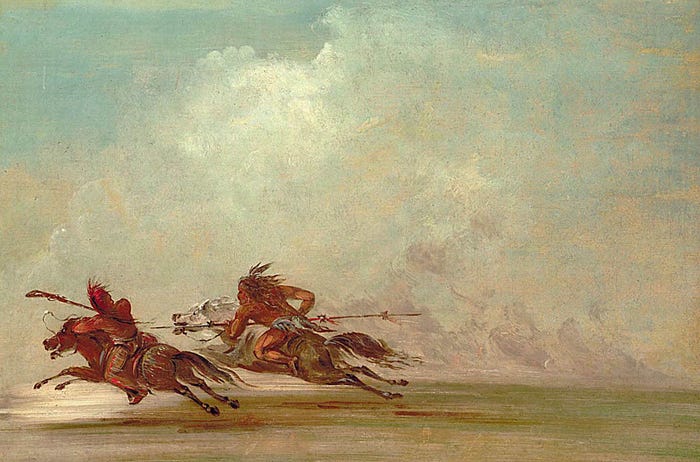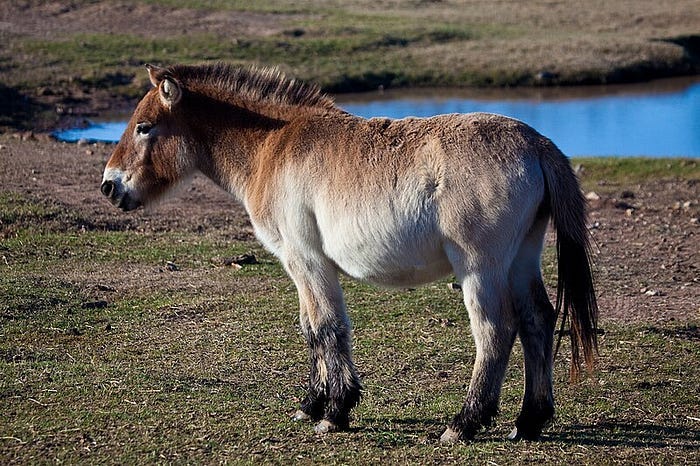When Did Horses Revolutionize the Way We Moved?
A recent study challenges the popular belief of horseriding associated with the Yamnaya migrations
What if everything we thought we knew about the origins of horseback riding was wrong?
In the previous newsletter, we examined the origins of the Indo-European language family and the perplexing issue of Anatolian languages, whose speakers had no Steppe ancestry. Traditionally, historians have believed horses aided the spread of Indo-European languages.
For decades, archaeologists such as Marija Gimbutas theorized the spread of Indo-European languages with the arrival of horseback riders from the Yamnaya culture, which thrived in the Pontic Caspian Steppes from 3400 to 2600 BC.
David W. Anthony's bestseller The Horse, the Wheel, and Language further popularized the idea of mounted horsemen disrupting civilizations across Europe and Asia. Backed by detailed archaeological fieldwork, Anthony's book suggested that the earliest horse riders emerged from the Eurasian Steppes by the 4th millennium BC.
In 2023, a groundbreaking population study examined Yamnaya skeletons and discovered bone pathologies which can be seen in long distance horse riders.
However, just a year later, a fresh study questioned these assumptions, reminding us that archaeology is a discipline where even the most persuasive theories may be refuted by stronger data.
This is the beauty of history: it is seldom black and white.
As someone who approaches theories with an open mind, I’m excited to explore one of the most transformative questions in human history: When did we first ride horses?
No other animal has influenced human mobility like the horse. Until the early 20th century, horses were the backbone of communications, logistics, and troop movement. But when did this partnership between humans and horses begin?
How long after we domesticated horses did we start riding them? Before we explore the theories, let’s review the basics: why did we domesticate horses in the first place?
Early history of horse domestication
Wild horses were common worldwide during the Upper Paleolithic era (50,000 to 12,000 years ago). Over 6,000 paintings of animals are in the 17,000-year-old Lascaux cave in France, with horses being the most numerous depictions.
Our ancestors were fascinated with the creature.
Scientists say human predation and competition with other species drove the wild horse to extinction in most regions by the sixth millennium BC. However, the animal thrived in one place on earth: the Eurasian Steppes.
Horsemeat is frowned upon in many parts of the world, particularly in the English-speaking world. But for prehistoric humans, it was crucial for survival. If you’re a horse lover, you won’t like it, but humans first domesticated horses for the same reason as cattle and sheep. For milk and meat, not transportation.
Horses were tamed in the Western Eurasian Steppes around the fourth millennium BC. They are better adapted to the harsh Steppe winters, and their powerful hooves can break frozen streams, allowing essential access to water. They thrive in environments where livestock can’t, making them the ideal candidate for domestication.
Stallions and mares live in separate herds. Early Steppe herders took advantage of this and domesticated the more docile mare. Only a few kinds of stallions were ever domesticated.
Why is this relevant?
Archaeologists in the mid-20th century cited the abundance of mare bones and the shortage of stallion bones as proof that the people of the Eurasian Steppes rode horses. They reasoned humans must have ridden horses when domesticating them. How else could early herders manage so many horses?

Archaeologists studied Native American tribes, such as the Comanche, who mastered horseriding shortly after the Spanish introduced horses to North America. The scholars theorized that a similar event must have occurred in the Eurasian Steppes. After humans came in close contact with horses, they started riding them.
If you’re tempted to buy this argument, hold your horses!
The 16th-century horses and their ancestors 6,000 years ago were quite different. Thanks to thousands of years of artificial selection, humans bred out the creature's aggressiveness. The early domesticated horses were more similar to their wild counterparts than the horses mastered by the Comanche.
In 2009, archaeologists discovered mare milk residue in pottery from a 6000-year-old archaeological site in north Kazakhstan. The findings changed our views about early horse riding.
The site we’re talking about is called Botai. Excavations revealed that 99.9% of all animal remains were horse bones. The people of the Botai culture, who lived from 3700 to 3100 BC, subsisted solely on horse meat.
Was there any other evidence from Botai that hinted at horse riding?
The Botai people: The first horse riders?

Anthony conducted a landmark study to propose the idea that horse riding was an established practice in the Eurasian Steppes by the 4th millennium BC. He noticed deterioration in the molars of the horses found at the site and compared the patterns of tooth degradation to those of a modern domestic horse.
The results were comparable.
According to the scientists, the erosion in the teeth of the Botai horses was caused by bit wear. A bit is a horse’s mouthpiece that applies pressure to the horse’s tongue when the rider pulls the attached reins.
The erosion patterns suggest that the people of Botai were horse riders. Early bits were usually made of bones or animal antlers, unlike the metal ones we use now. Hence, the bits from Botai didn’t survive.
We have evidence of bits made of antler bones from other archaeological sites in the Steppes, though they’re dated after 2500 BC, over a millennium after Botai culture vanished.
The study was a watershed moment in horse history since it convinced several researchers that the Botai people were the first to domesticate horses. It fits the theory of horseriding with early domestication, as hypothesized in the 20th century.
Case closed, right?
Not so fast!
Later research revealed several significant shortcomings of earlier studies.
A 2018 DNA analysis discovered that the Botai horses were the ancestors of the Przewalski’s horse (Equus przewalskii), a species distinct from the domestic horse (Equus caballus). The short and stocky Przewalski’s horse is a feral creature, similar to the Mustang. According to researchers, the Botai horse contributed only 2.7% of the DNA of the present-day horse. Hence, horse domestication must have happened elsewhere.
Anthony's evidence was indirect. Bit wear pieces weren’t found in Botai. A 2021 study by William Timothy Treal Taylor and Christina Isabelle Barrón-Ortiz found that the erosion observed in Botai horses’ teeth was natural rather than caused by bit wear.
Another study, in 2021, of the dental remains of individuals buried at Botai found no milk proteins in their teeth.
Though Botai clearly had a horse-subsistence-based economy, there is little evidence of the creatures being used for long-distance riding.
Hence, we must look elsewhere to discover when humans first started riding horses.
Unlock this exclusive post by becoming a paid subscriber. As a special offer for being part of our history-loving community, enjoy 15% OFF on annual subscriptions FOREVER. This is a limited-time offer and only valid till February 20th!
Keep reading with a 7-day free trial
Subscribe to Forgotten Footprints to keep reading this post and get 7 days of free access to the full post archives.


